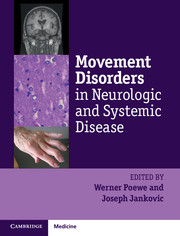Book contents
- Frontmatter
- Contents
- List of contributors
- List of videos
- List of abbreviations
- Preface
- Section I General principles
- Section II Movement disorders in systemic disease
- Chapter 4 Paraneoplastic movement disorders
- Chapter 5 Movement disorders of autoimmune origin
- Chapter 6 Movement disorders in systemic infections
- Chapter 7 Movement disorders in HIV- and AIDS-related central nervous system infections
- Chapter 8 Movement disorders in metabolic diseases in adulthood
- Chapter 9 Movement disorders in childhood metabolic diseases
- Chapter 10 Movement disorders in endocrinological diseases
- Chapter 11 Movement disorders in liver disease
- Chapter 12 Movement disorders in renal diseases
- Chapter 13 Movement disorders in hematological disease
- Section III Iatrogenic and toxic movement disorders
- Section IV Movement disorders in general neurology
- Section V Systemic complications of movement disorders
- Index
- Plate Section
- References
Chapter 8 - Movement disorders in metabolic diseases in adulthood
from Section II - Movement disorders in systemic disease
Published online by Cambridge University Press: 05 April 2014
- Frontmatter
- Contents
- List of contributors
- List of videos
- List of abbreviations
- Preface
- Section I General principles
- Section II Movement disorders in systemic disease
- Chapter 4 Paraneoplastic movement disorders
- Chapter 5 Movement disorders of autoimmune origin
- Chapter 6 Movement disorders in systemic infections
- Chapter 7 Movement disorders in HIV- and AIDS-related central nervous system infections
- Chapter 8 Movement disorders in metabolic diseases in adulthood
- Chapter 9 Movement disorders in childhood metabolic diseases
- Chapter 10 Movement disorders in endocrinological diseases
- Chapter 11 Movement disorders in liver disease
- Chapter 12 Movement disorders in renal diseases
- Chapter 13 Movement disorders in hematological disease
- Section III Iatrogenic and toxic movement disorders
- Section IV Movement disorders in general neurology
- Section V Systemic complications of movement disorders
- Index
- Plate Section
- References
Summary
Introduction
Inborn errors of metabolism (IEMs) are a wide and variegate, mostly recessively inherited group of multi-systemic diseases that often involve the central nervous system (CNS). Onset of symptoms in childhood or adolescence is generally the rule, but presentation in adulthood is not exceptional and should be taken into consideration in the differential diagnosis even in adult patients presenting with complex movement disorders.
Neurologists may face two scenarios in metabolic disorders of adulthood: late-onset metabolic diseases sometimes manifesting with neurological symptoms, including movement disorders or movement disorders developing later in the context of an earlier-onset and previously diagnosed IEM.
The latter circumstance is becoming increasingly frequent as early diagnosis, improvement of standards of care for patients diagnosed in early childhood, and a multidisciplinary approach in the treatment of these disorders, as well as the availability of new therapies, has considerably prolonged the life expectancy of these patients, so that several long-term neurological manifestations due to CNS involvement, including movement disorders, are now being observed with increasing frequency. Movement disorders in IEMs are clinically heterogeneous and include a wide spectrum of manifestations, from dystonia to ataxia, with different patterns and course; for this reason, considering metabolic diseases in the differential diagnosis is of primary importance in adults, especially when presenting with signs and symptoms of involvement of other organs. Most importantly, such diagnoses should not be missed as some of these disorders (for example, Wilson’s disease) are treatable and some of the movement disorders themselves can also be treated symptomatically.
- Type
- Chapter
- Information
- Movement Disorders in Neurologic and Systemic Disease , pp. 99 - 114Publisher: Cambridge University PressPrint publication year: 2014



